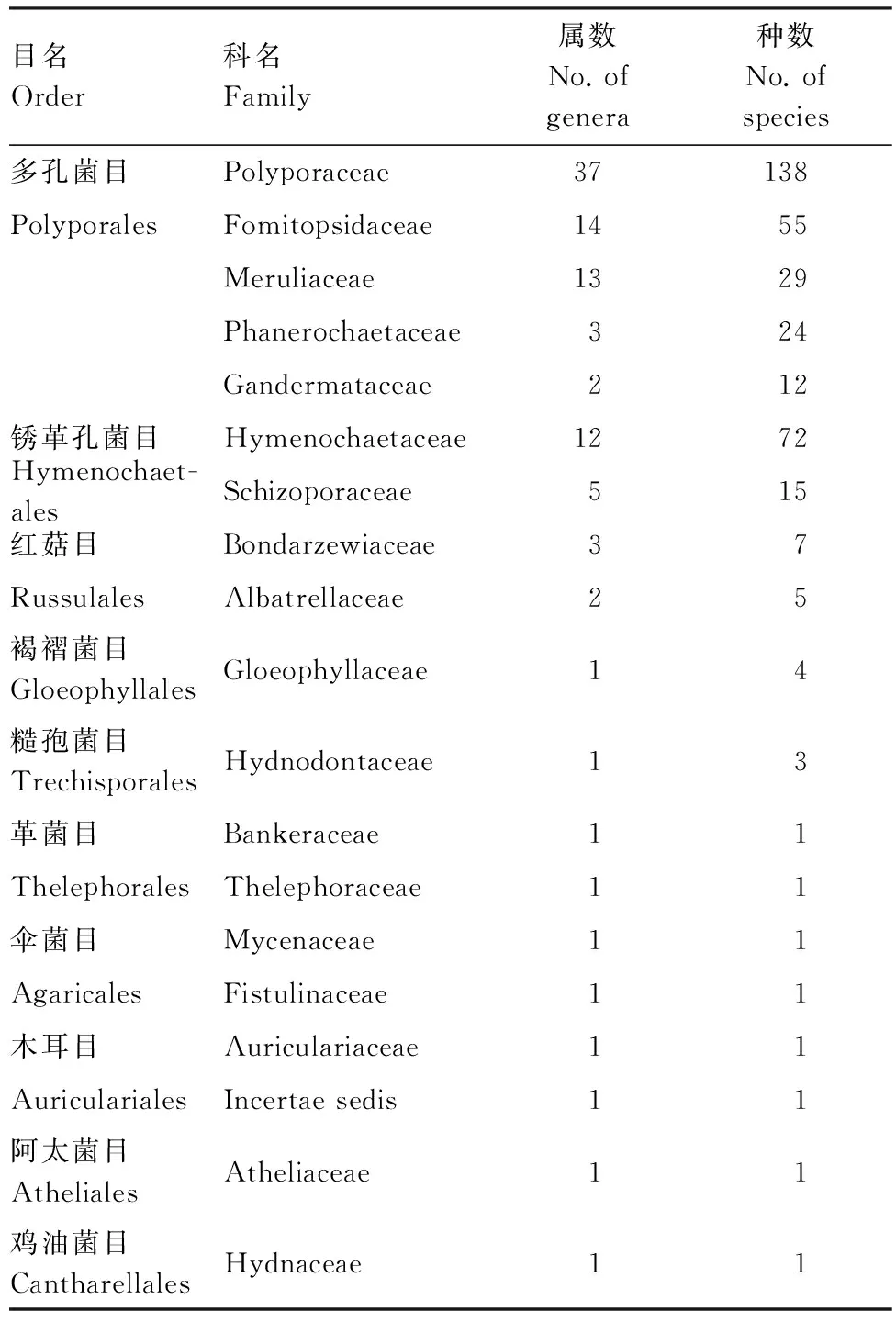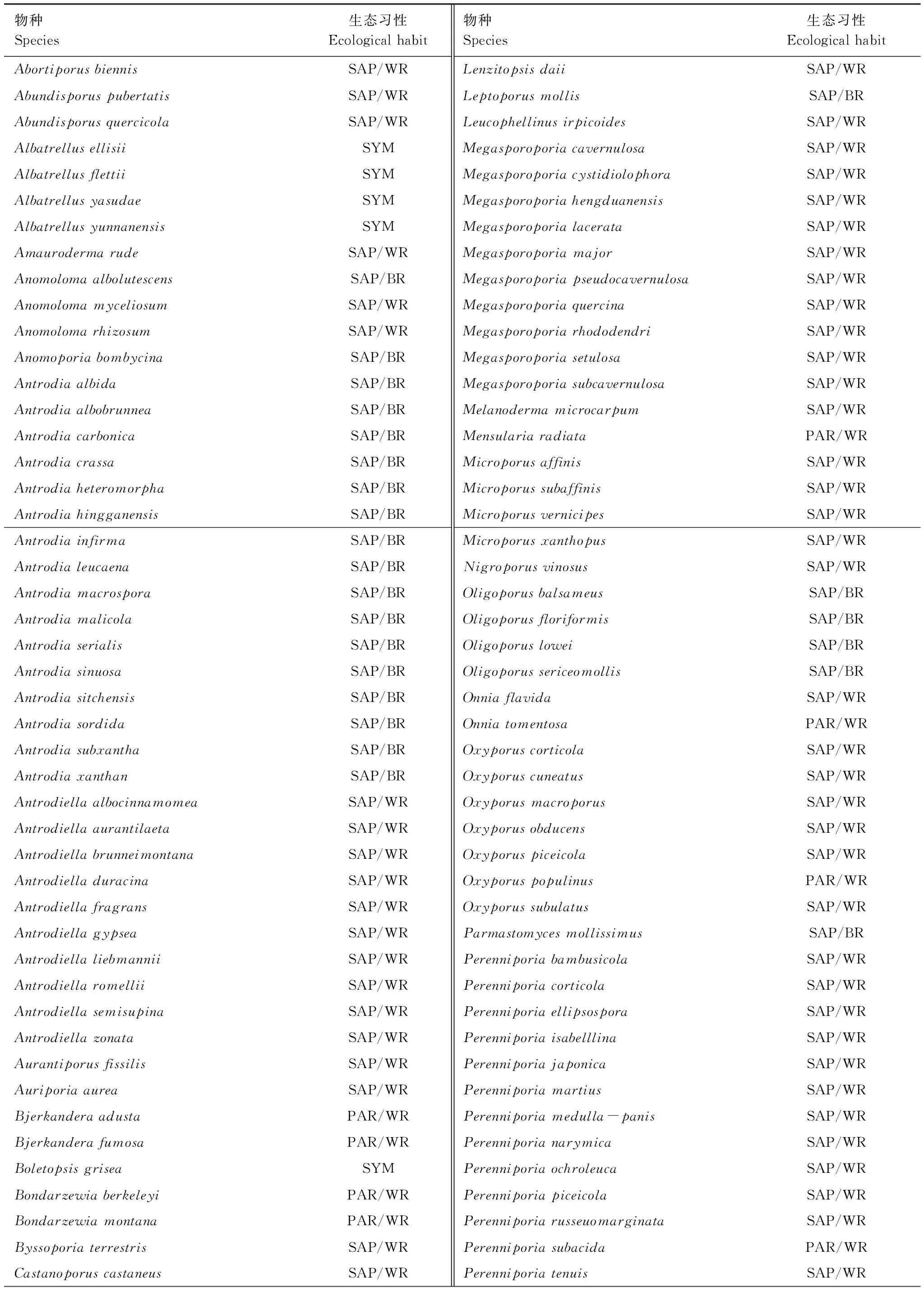东喜马拉雅地区多孔菌区系和生态习性
2015-03-11边禄森戴玉成
边禄森, 戴玉成
北京林业大学微生物研究所,北京 100083
东喜马拉雅地区多孔菌区系和生态习性
边禄森, 戴玉成*
北京林业大学微生物研究所,北京 100083
对东喜马拉雅地区多孔菌区系和生态习性进行了分析,发现该地区多孔菌极为丰富,共有10 目19 科101 属372 种,其中优势科为多孔菌科和锈革孔菌科,优势属为木层孔菌属和多孔菌属。种的区系地理成分可以分为8 类,其中北温带类型种类最多,表明东喜马拉雅地区多孔菌具有明显的北温带区系特征。该地区的多孔菌有常见种、偶见种、稀有种和濒危种分别为156、141、54和21 个;有腐生菌304 种、寄生菌49 种、菌根菌19 种。在寄主方面,能够生长在被子植物上的有256 种,裸子植物上的有137 种,既能生长在被子植物,也能生长在裸子植物上的有40 种,地上生长的有19 种。东喜马拉雅地区的裸子植物,特别是云杉属、松属和冷杉属树木对于多孔菌的生长更重要,因为生长在这些属树木上的多孔菌分别有71、68和51 种,高于该地区被子植物其他属树木上的多孔菌。
多孔菌;真菌区系;多样性;生态习性
东喜马拉雅地区泛指我国西藏东南部及雅鲁藏布江大拐弯处以东, 包括北纬28°30′以南的横断山脉地区[1]。东喜马拉雅植物区系的丰富复杂程度稍次于横断山脉地区,但垂直分布更为集中,环境条件十分优越而复杂,从热带到寒温带植被均有分布,所以植物种类异常繁多[2],为木生真菌提供了丰富的生长基质。
多孔菌系指广义非褶菌目(Aphylloporales)中具有孔状子实层体的种类,按照现代分类系统包括担子菌门中多孔菌目Polyporales、锈革孔菌目Hymenochaetales、褐褶菌目Gloeophyllales、糙孢孔目Trechisporales、革菌目Corticiales、糙孢革菌目Thelephorales 和红菇目Russulales 中孔状子实体的种类,还有伞菌目Agaricales、阿太菌目Atheliales、鸡油菌目Cantharellales、木耳目Auriculariales 中的少数属,如网孔菌属Dictyopanus和胶孔菌属Favolaschia、榆孔菌属Elmerina、牛排菌属Fistulina和纵隔孔菌属Protomerulius等[3]。多孔菌的绝大部分种类生长在天然林中,但有些种类也能生长在人为干扰较大的地区[4- 5],多孔菌通常生长在树木及其腐朽木上,但少数种类也生长在腐朽竹子上[6]。
多孔菌不仅是重要的生物资源,还在生态系统中起着重要的分解还原作用,与其他菌物和微生物一起维持着生态系统的物质循环和能量流动[7]。大部分多孔菌为腐生种类,但也有不少种类能够引起林木腐朽病害[8],尽管多孔菌子实体的质地多数是木栓质,但少数种类在子实体幼嫩时也是食用菌[9],如大孢地花孔菌Albatrellusellisii、灰黑拟牛肝孔菌Boletopsisgrisea、牛排菌Fistulinahepatica等。多孔菌的很多种类具有特殊药用价值,是重要的药用真菌[10- 11],如灵芝Ganodermalingzhi、桑黄Inonotussanghuang、樟芝Taiwanofunguscamphoratus等。此外,有些多孔菌可以降解农药、染料等复杂化合物[12- 14],在工业生产和环境治理等领域有良好应用前景。
真菌区系是指一定区域所有真菌或某类真菌种类的总称,是真菌在一定自然环境、特别是自然历史环境中发展演化的结果。真菌区系地理学是研究世界或某一区域所有真菌种类的组成、分布以及它们的起源和演化历史的科学[15]。
1 研究材料与方法
本文研究材料来源于本课题组过去10 年在东喜马拉雅地区的多次实地考察[16- 23],详细记录了多孔菌的生境和生态习性,参考真菌地理分析报道[24- 27]对东喜马拉雅地区多孔菌区系进行分析。
2 区系组成及优势科属分析
2.1 区系组成
对东喜马拉雅地区多孔菌的调查显示,该地区共有372 种(见附表),隶属于10 目19 科101 属,区系组成见表1。

表1 东喜马拉雅地区多孔菌区系组成Table 1 The flora of polypores in eastern Himalayas
2.2 优势科属分析
根据表1可知,东喜马拉雅地区多孔菌在多孔菌科Polyporaceae和锈革孔菌科Hymenochaetaceae最丰富,其中多孔菌科共有138 种,占全部种类的37.1%;锈革孔菌科共有72 种,占全部种类的19.4%。两个科合计共210 种,占所有种的56.5%。其次为拟层孔菌科Fomitopsidaceae 55 种,皱皮菌科Meruliaceae 29 种和原毛平革菌科Phanerochaetaceae 24 种,分别占全部种的14.8%,7.8%和6.5%。
东喜马拉雅地区多孔菌共有101 个属,根据种的多少判断,该地区优势属为木层孔菌属Phellinus和多孔菌属Polyporus,种数分别为34 种和20 种,所占比例分别为9.1%和5.4%。两属共有种数54 种,占东喜马拉雅山地区全部种数的14.5%,而属的数目仅占全部属的2%。其次,薄孔菌属Antrodia(16 种),泊氏孔菌属Postia(15 种)和栓孔菌属Trametes(15 种)也占有较大比例。
3 区系地理成分分析
真菌区系的地理成分一般是按照属或种的分布类型划分的。由于目前对各属种的现代分布区尚未完全了解,所以地理成分分析的准确性只能是相对的。
3.1 科的地理成分分析
在东喜马拉雅山地区分布多孔菌确定的18 个科中,世界广布科有:多孔菌科Polyporaceae、皱皮菌科Meruliaceae、原毛平革菌科Phanerochaetaceae、锈革孔菌科Hymenochaetaceae、裂孔菌科Schizoporaceae、刺孢多孔菌科Bondarzewiaceae、刺孢菌科Hydnodontaceae、木耳科Auriculariaceae;北温带分布科有:拟层孔菌科Fomitopsidaceae、地花孔菌科Albatrellaceae、褐褶菌科Gloeophyllaceae、烟白齿菌科Bankeraceae、革菌科Thelephoraceae、牛舌菌科Fistulinaceae、阿太菌科Atheliaceae、齿菌科Hydnaceae;热带亚热带成分的科有:灵芝科Ganodermataceae、小菇科Mycenaceae。
3.2 属的地理成分分析
根据种的地理分布成分研究,可将东喜马拉雅山地区分布的多孔菌101 个属的分布型分为以下几类。
(1)世界广布属
世界广布属一般指广泛分布于世界各大洲,无特殊分布中心的属。东喜马拉雅山地区多孔菌的世界广布属有:Abortiporus、Antrodia、Auriporia、Antrodiella、Bjerkandera、Ceriporia、Ceriporiopsis、Cerrena、Daedalea、Daedaleopsis、Datronia、Dichomitus、Fomitiporia、Fomitopsis、Ganoderma、Gloeophyllum、Gloeoporus、Haploporus、Heterobasidion、Hyphodontia、Inocutis、Inonotus、Irpex、Junghuhnia、Laetiporus、Lenzites、Megasporoporia、Oxyporus、Perenniporia、Phaeolus、Phellinus、Phylloporia、Polyporus、Pycnoporus、Rigidoporus、Skeletocutis、Stromatoscypha、Trametes、Trechispora、Trichaptum、Tyromyces等,共41 个属,占全部属的40.6%。
(2)北温带分布属
北温带分布属一般指分布中心在北半球温带地区,个别可以到达南半球温带地区,但主要分布中心仍在北温带的属。东喜马拉雅山地区多孔菌中北温带分布属有:Abundisporus、Albatrellus、Anomoloma、Anomoporia、Aurantiporus、Boletopsis、Bondarzewia、Byssoporia、Castanoporus、Cinereomyces、Climacocystis、Coltricia、Coltriciella、Cryptoporus、Diplomitoporus、Erastia、Fibroporia、Fistulina、Fomes、Gelatoporia、Grifola、Hapalopilus、Ischnoderma、Jahnoporus、Lenzitopsis、Leptoporus、Leucophellinus、Melanoderma、Mensularia、Oligoporus、Onnia、Parmastomyces、Phellinidium、Physisporinus、Piptoporus、Poriodontia、Postia、Pouzaroporia、Protomerulius、Pyrrhoderma、Rhodonia、Sarcoporia、Sistotrema、Wolfiporia、Wrightoporia等,共45 个属,占全部属的44.6%。
(3)热带-亚热带分布属
热带-亚热带分布属主要分布于东西两半球的热带地区,有的可以到达亚热带至温带,但主要分布区仍然在热带地区。东喜马拉雅山地区多孔菌的热带-亚热带分布属有:Amauroderma、Coriolopsis、Cyclomyces、Earliella、Echinochaete、Echinoporia、Elmerina、Favolaschia、Funalia、Hexagonia、Hydnopolyporus、Microporus、Nigroporus、Pyrofomes、Tinctoporellus,共15 个属,占全部属的14.9%。
表2 东喜马拉雅山地区多孔菌种在不同地理区域的分布
Table 2 Geographicaldistribution of polypore flora in eastern Himalayas

地理区域Geographicalarea种数No.ofspecies百分比Percentage%北温带Northtemperate11932.0泛热带Pantropical6216.7世界广布Cosmopolitan6016.1中国特有EndemictoChina4612.4东亚EastAsia338.9东亚-北美EastAsia-NorthA-merica256.7东亚-欧洲EastAsia-Europe184.8热带亚洲TropicalAsia92.4总计Total372100
3.3 种的地理成分分析
东喜马拉雅山地区多孔菌的区系地理成分如表2所示,从表中可以看出,东喜马拉雅山地区的多孔菌区系地理成分以北温带成分为主,其次为泛热带成分和世界广布成分,其它几种区系成分也有一定分布,但该地区具有明显的北温带成分区系特征。虽然该地区热带-亚热带分布的属远少于世界广布属,但其种类却多于世界广布种,说明该地区热带-亚热属中包括的种类丰富。
4 生态习性分析
根据出现频度,东喜马拉雅山地区的多孔菌可以划分为4 类,其中常见种数量最多,为156 个,其次为偶见种141 个,稀有种54 个,濒危种21 个,分别占全部种类的42%、37.9%、14.5%和5.6%。根据营养方式,可将东喜马拉雅山地区多孔菌分为3 类:腐生菌304 种,寄生菌49 种,共生菌根菌19 种,分别占全部种类的81.7%、12.9%和5.1%。地生多孔菌有19 种,为非木材腐朽菌,而腐生和寄生都属于木材腐朽真菌,共有353 种,占全部种类的94.9%,其中能够引起木材褐色腐朽的有60 种,占17.0%;能够引起木材白色腐朽的有293 种,占83.0%。能够生长在裸子植物上的有137 种,能够生长在被子植物上的有256 种。其中,只能生长在裸子植物上的有96 种,只能生长在被子植物上的有215 种,既能生长在裸子植物上又能生长在被子植物上的有40 种。
在裸子植物上发现的137 种多孔菌中,生长在云杉属上的有71 种,其次为松属68 种、冷杉属51 种、铁杉属和落叶松属各15 种;在被子植物上发现的256 种多孔菌中,生长在栎属树木上的42 种,其次为桦木属37 种、栲属31 种和杨属23 种。东喜马拉雅地区的裸子植物,特别是云杉属、松属和冷杉属树木对于多孔菌的生长更重要,因为生长在这些属上的多孔菌高于该地区被子植物其他属上的多孔菌。
5 讨论
世界范围内对多孔菌研究比较深入的是欧洲和北美洲[26- 28],欧洲和北美洲不但对多孔菌的种类有深入研究,还特别对其在北半球的区系进行了研究,将多孔菌的区系分为温带广布、欧洲、北美洲、亚洲、欧洲-亚洲、欧洲-北美、北美-亚洲等13 个成分[29]。但是由于对热带地区多孔菌研究还不充分[30],因此对热带地区多孔菌区系的认识还是初步的。本文的分析也是基于目前对世界多孔菌区系认识基础上来论述东喜马拉雅地区的多孔菌,随着对热带地区多孔菌种类和区系研究的深入,将来也有助于对东喜马拉雅地区的多孔菌区系的认识。
中国近年对多孔菌进行了广泛和系统的研究,目前已经报道多孔菌132 属和705 种[31],研究最深入的地区有东北地区和喜马拉雅地区,其中101 属和372 种发现于东喜马拉雅地区,分别占全国的76.5%和52.7%,说明东喜马拉雅地区多孔菌种类十分丰富。中国东北地区共发现多孔菌96 属300 种[32],分别占全国的73% 和42%,23 种多孔菌描述于中国东北地区,但44 种描述于东喜马拉雅地区。尽管中国东北地区的森林面积比东喜马拉雅地区大,但东喜马拉雅地区多孔菌的丰富度高于东北地区。
近年来随着物种多样性的研究越来越受到人们关注,中国大型真菌的区系和地理成分分析也越来越广泛,研究地区包括云南[33]、江西[34]、安徽[35- 36]、陕西[37]、广西[38]、内蒙古[39- 41]、吉林[42- 43]等地,研究内容涵盖区系组成、生态习性、地理成分、种群结构、相似性分析等,并且逐渐向着更深入、更具体、更精确的方向发展,对大型真菌的发现、研究、利用、保护有着重要的指导和借鉴意义。
[1] 臧穆, 纪大干. 我国东喜马拉雅区鬼笔科的研究. 真菌学报, 1984, 4(2): 109- 117.
[2] 吴征镒. 论中国植物区系的分区问题. 云南植物研究, 1979, 1(1): 1- 20.
[3] 戴玉成. 中国多孔菌名录. 菌物学报, 2009, 28(3): 315- 327.
[4] Dai Y C, Yuan H S, He W, Decock C. Polypores from Beijing area, northern China. Mycosystema, 2006, 25(3): 368- 373.
[5] Cui B K, Wei Y L, Dai Y C. Polypores from Zijin Mountain, Jiangsu Province. Mycosystema, 2006, 25(1): 9- 14.
[6] 徐梅卿, 戴玉成, 范少辉, 金立新, 吕全, 田国忠, 汪来发. 中国竹类病害记述及其病原物分类地位(上). 林业科学研究, 2006, 19(6): 692- 699.
[7] 魏玉莲, 戴玉成. 木材腐朽菌在森林生态系统中的功能. 应用生态学报, 2004, 15(10): 1935- 1938.
[8] 戴玉成. 中国木本植物病原木材腐朽菌研究. 菌物学报, 2012, 31(4): 493- 509.
[9] 戴玉成, 周丽伟, 杨祝良, 文华安, 图力古尔, 李泰辉. 中国食用菌名录. 菌物学报, 2010, 29(1): 1- 21.
[10] 戴玉成, 杨祝良. 中国药用真菌名录及部分名称的修订. 菌物学报, 2008, 27(6): 801- 824.
[11] 戴玉成, 李玉. 中国六种重要药用真菌名称的说明. 菌物学报, 2011, 30(4): 516- 518.
[12] 司静, 崔宝凯, 戴玉成. 栓孔菌属漆酶高产菌株的初步筛选及其产酶条件的优化. 微生物学通报, 2011, 38(3): 405- 416.
[13] 司静, 崔宝凯, 戴玉成. 东方栓孔菌在染料脱色中的应用及其脱色条件的优化. 基因组学与应用生物学, 2011, 30(3): 364- 371.
[14] 袁海生, 戴玉成, 曹云, 杨建. 白腐真菌染料脱色菌株的筛选及一色齿毛菌脱色条件的研究. 菌物学报, 2010, 29(3): 429- 436.
[15] 崔宝凯, 余长军. 大兴安岭林区多孔菌的区系组成与种群结构. 生态学报, 2011, 31(13): 3700- 3709.
[16] Cui B K, Dai Y C. Wood-decaying fungi in eastern Himalayas 3. Polypores from Laojunshan Mountains, Yunnan Province. Mycosystema, 2012, 31(4): 486- 492.
[17] Dai Y C, Zhou T X. A new species ofInonotus(Basidiomycotina) from Yunnan, southern China. Mycotaxon, 2000, 74(2): 331- 335.
[18] Dai Y C, Wei Y L, Wang Z. Wood-inhabiting fungi in southern China 2. Polypores from Sichuan Province. Annales Botanici Fennici, 2004, 41(5): 319- 329.
[19] Dai Y C, Yu C J, Wang H C. Polypores from eastern Xizang (Tibet), western China. Annales Botanici Fennici, 2007, 44(2): 135- 145.
[20] Dai Y C, Zhou L W, Steffen K. Wood-decaying fungi in eastern Himalayas 1. Polypores from Zixishan Nature Reserve, Yunnan Province. Mycosystema, 2011, 30(5): 674- 679.
[21] Dai Y C, He X S, Wanghe K Y, Steffen K. Wood-decaying fungi in eastern Himalayas 2. Species from Qingcheng Mts., Sichuan Province. Mycosystema, 2012, 31(2): 168- 173.
[22] Dai Y C, Cui B K, He S H, Dimtry S. Wood-decaying fungi in eastern Himalayas 4. Species from Gaoligong Mountains, Yunnan Province, China. Mycosystema, 2013 (in press).
[23] Yuan H S, Dai Y C. Polypores from northern and central Yunnan Province, southwestern China. Sydowia, 2008, 60(1): 147- 159.
[24] Nunez M, Ryvarden L. East Asian Polypores 1. Ganodermataceae and Hymenochaetaceae. Synopsis Fungorum, 2000, 13: 1- 168.
[25] Nunez M, Ryvarden L. East Asian Polypores 2. Polyporaceae s. lato. Synopsis Fungorum, 2001, 14: 170- 522.
[26] Ryvarden L, Gilbertson R L. European Polypores Part 1. Synopsis Fungorum, 1993, 6: 1- 387.
[27] Ryvarden L, Gilbertson R L. European Polypores Part 2. Synopsis Fungorum, 1994, 7: 389- 743.
[28] Gilbertson R L, Ryvarden L. North American Polypores. Oslo: Fungiflora, 1986- 1987: 1-885.
[29] Ryvarden L. Genera of polypores: nomenclature and taxonomy. Synopsis Fungorum, 1991, 5: 1- 363.
[30] Ryvarden L, Johansen I. A Preliminary Polypore Flora of East Africa. Oslo: Fungiflora, 1980: 1- 636.
[31] Dai Y C. Polypore diversity in China with an annotated checklist of Chinese polypores. Mycoscience, 2012, 53(1): 49-80.
[32] Dai Y C. Species diversity of wood-decaying fungi in Northeast China. Mycosystema, 2010, 29(6): 801-818.
[33] Zhang Y, Zhou D Q, Zhou T S, Ou X K. New records and distribution of macrofungi in Laojun Mountain, Northwest Yunnan, China. Mycosystema, 2012, 31(2): 196- 212.
[34] 陈晔, 詹寿发, 彭琴, 樊有赋, 杜天真. 赣西北地区森林大型真菌区系成分初步分析. 吉林农业大学学报, 2011, 33(1): 31- 35.
[35] 柴新义, 许雪峰, 汪美英, 向玉勇, 殷培峰, 朱双杰. 安徽琅琊山大型真菌区系多样性. 生态学报, 2013, 33(4): 2314- 2319.
[36] 柴新义, 朱双杰, 殷培峰, 向玉勇. 安徽皇埔山大型真菌区系地理成分分析. 生态学杂志, 2012, 31(9): 2344- 2349.
[37] 王晓亮, 赵德怀, 麻应太. 陕西牛背梁国家级自然保护区大型真菌区系特征研究. 陕西林业科技, 2012, (5): 7- 14, 19- 19.
[38] 吴兴亮, 李泰辉, 宋斌. 广西花坪国家级自然保护区大型真菌资源及生态分布. 菌物学报, 2009, 28(4): 528- 534.
[39] 图力古尔,李玉. 大青沟自然保护区大型真菌物种多样性的研究. 吉林农业大学学报, 1999, 21(3): 36- 45.
[40] 李玉, 图力古尔. 大青沟自然保护区大型真菌群落多样性的研究. 生态学报, 2000, 20(6): 986- 991.
[41] 图力古尔,李玉. 大青沟自然保护区大型真菌区系多样性的研究. 生物多样性,2000, 8(1): 73- 80.
[42] 图力古尔,陈今朝,王耀,范宇光. 长白山阔叶红松林大型真菌多样性. 生态学报, 2010, 30(17): 4549- 4558.
[43] 图力古尔, 王耀,范宇光. 长白山针叶林带大型真菌多样性. 东北林业大学学报, 2010, 38(11): 97- 100.
Mycota and ecology of polypores in eastern Himalayas
BIAN Lusen, DAI Yucheng*
InstituteofMicrobiology,BeijingForestryUniversity,Beijing100083,China
Polypores are a kind of wood-decaying macro-fungi. They produce poroid hymenophore, and play essential roles in the natural renewal of forest ecosystems because they have ability to fully decompose lignocellulose of wood. Most species of polypores belong to the Polyporales, Hymenochaetales, Gloeophyllales, Trechisporale, Corticiales and Thelephorales according to the current taxonomy. In this study, the mycota and ecology of polypores in eastern Himalayas were studied. A total of 372 polypore species belonging to 10 orders, 19 families and 101 genera were recognized. Among the 19 families, Polyporaceae and Hymenochaetaceae, being composed of 138 and 72 species, respectively, are the dominant families. These 210 species in the two families account for 56.5% of the total species found in the studied area. Other large families include the Fomitopsidaceae, Meruliaceae and Phanerochaetaceae, comprising 55, 29 and 24 species, respectively. The cosmopolitan families are Polyporaceae, Meruliaceae, Phanerochaetaceae, Hymenochaetaceae, Schizoporaceae, Bondarzewiaceae, Hydnodontaceae and Auriculariaceae, the north temperate families are Fomitopsidaceae, Albatrellaceae, Gloeophyllaceae, Bankeraceae, Thelephoraceae, Fistulinaceae, Atheliaceae and Hydnaceae, while the tropical and subtropical families are Ganodermataceae and Mycenaceae. The dominant genera arePhellinusandPolyporus, and 34 and 20 species were found in the two genera, respectively. The species in these two genera, occupying 2% of the total 19 genera, account for 14.5% of the total polypore species in the studied area. Other large genera areAntrodia,PostiaandTrametes, respectively, with 16, 15 and 15species. The cosmopolitan genera areAbortiporus,Antrodia,Auriporia,Antrodiella,Bjerkandera,Ceriporia,Ceriporiopsis,Cerrena,Daedalea,Daedaleopsis,Datronia,Dichomitus,Fomitiporia,Fomitopsis,Ganoderma,Gloeophyllum,Gloeoporus,Haploporus,Heterobasidion,Hyphodontia,Inocutis,Inonotus,Irpex,Junghuhnia,Laetiporus,Lenzites,Megasporoporia,Oxyporus,Perenniporia,Phaeolus,Phellinus,Phylloporia,Polyporus,Pycnoporus,Rigidoporus,Skeletocutis,Stromatoscypha,Trametes,Trechispora,TrichaptumandTyromyces, the north temperate genera areAbundisporus,Albatrellus,Anomoloma,Anomoporia,Aurantiporus,Boletopsis,Bondarzewia,Byssoporia,Castanoporus,Cinereomyces,Climacocystis,Coltricia,Coltriciella,Cryptoporus,Diplomitoporus,Erastia,Fibroporia,Fistulina,Fomes,Gelatoporia,Grifola,Hapalopilus,Ischnoderma,Jahnoporus,Lenzitopsis,Leptoporus,Leucophellinus,Melanoderma,Mensularia,Oligoporus,Onnia,Parmastomyces,Phellinidium,Physisporinus,Piptoporus,Poriodontia,Postia,Pouzaroporia,Protomerulius,Pyrrhoderma,Rhodonia,Sarcoporia,Sistotrema,WolfiporiaandWrightoporia, while the tropical and subtropical genera areAmauroderma,Coriolopsis,Cyclomyces,Earliella,Echinochaete,Echinoporia,Elmerina,Favolaschia,Funalia,Hexagonia,Hydnopolyporus,Microporus,Nigroporus,PyrofomesandTinctoporellus. The 372 polypore species in eastern Himalayas were geographically classified into eight groups, north temperate, pantropical, cosmopolitan, endemic to China, East Asia, East Asia-North America, East Asia-Europe and tropical Asia, respectively, including 119, 62, 60, 46, 33, 15, 18 and nine species. That is to say most of polypores in eastern Himalayas are the boreal and temperate elements, and the mycota of polypores in eastern Himalayas has typically characteristics of boreal and temperate group. The common, occasional, rare and endangered polypores comprise, respectively, 156, 141, 54 and 21 species. 304, 49 and 19 polypore species were identified, respectively, as saprophytic, parasitic and mycorrhizal fungi. 256 polypore species occur on angiosperm wood, 137 species grow on gymnosperm wood, while 40 species inhabit both angiosperm and gymnosperm wood. Polypores are more common on gymnosperm wood than on angiosperm wood in eastern Himalayas. 71, 68 and 51 polypore species were found, respectively, on Picea, Pinus and Abies, while less than 50 species were recorded on all angiosperm genera.
polypore; fungal flora; diversity; ecological habit

附表1 东喜马拉雅地区多孔菌种类组成Attached table 1 Species diversity of polypores in eastern Himalayas
SAP: 腐生saprophytic; SYM: 共生symbiotic; PAR: 寄生parasitic; WR: 白色腐朽white rot;BR: 褐色腐朽brown rot
国家自然科学基金(31070022)
2013- 05- 15;
日期:2014- 04- 17
10.5846/stxb201305151067
*通讯作者Corresponding author.E-mail: yuchengd@yahoo.com
边禄森, 戴玉成.东喜马拉雅地区多孔菌区系和生态习性.生态学报,2015,35(5):1554- 1563.
Bian L S, Dai Y C.Mycota and ecology of polypores in eastern Himalayas.Acta Ecologica Sinica,2015,35(5):1554- 1563.
